Besides being a window to the soul, our eyes are also regarded as the window to our heart. These two vital organs, though may not seem to be linked, share many similar features particularly in the aspects of their blood vessels.
Network of blood vessels at the back of the eye is closely related to heart health. These blood vessels at the back of the eye are the only visible vasculature accessible in a human body without relying on an invasive method. An eye examination with careful viewing of the inner and outer part of the eye often can reveal early signs of cardiovascular disease (which may later present acutely as heart attack or stroke).
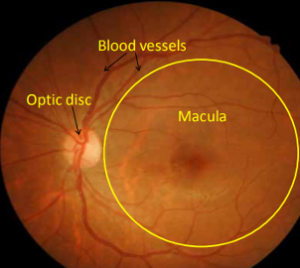
Photo 1 – Features at the back of the left eye with normal blood vessels
Based on the results of the National Health and Morbidity Survey 2019, three in 10 Malaysians had high blood pressure. At the early stage, high blood pressure typically has no warning symptom. Thus, many people are not aware of having high blood pressure until they develop end organ damage. An eye doctor may be able to discover early clues by recognizing changes in the eye’s blood vessels or small bleeding spots at the back of the eye. Sometimes, even a blocked artery with a blood clot leading to an impending eye stroke can be picked up by an experienced ophthalmologist.
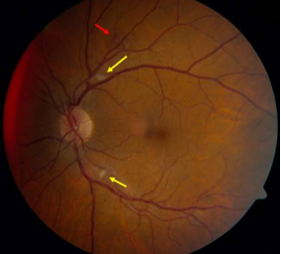
Photo 2 – Hypertensive changes at the back of the left eye (yellow arrow – death of nerve layer, red arrow – bleeding spot)
It is estimated that two out of 10 adults in Malaysia have diabetes. High blood sugar may damage the tiny blood vessels of the eye and cause leakage of fluid into the surrounding tissue. These conditions are known as diabetic retinopathy and diabetic macular edema respectively; if untreated, may lead to vision impairment or ultimately blindness. Ideally, these reversible conditions should be identified before visual loss occurs. For type 2 diabetes patients, diabetic retinopathy screening is recommended and should be carried out annually.
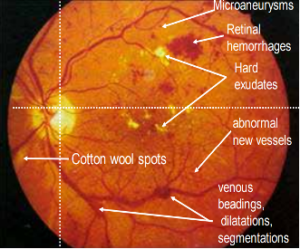
Photo 3 – Diabetic retinopathy of the left eye
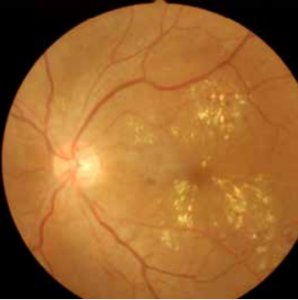
Photo 4 – Diabetic macular edema of the left eye, showing hard exudates around the macula
Notably four in 10 Malaysian adults have raised total cholesterol level, with one in 4 are unaware of it. Fortunately, such condition may occasionally manifest as small, yellowish soft bumps (called xanthelasma palpebrarum) around the eyelids. These aesthetically-unpleasing plagues rarely affect our vision but they may indicate a high cholesterol problem. Individuals who have such eye plaques should get their cholesterol levels checked.
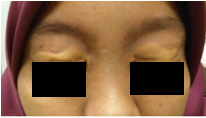
Photo 5 – Yellowish bumps on both upper eyelids (xanthelasma palpebrarum)
In short, early detection and subsequent treatment of risk factors of cardiovascular disease (namely high blood pressure, diabetes, high cholesterol) via an eye examination can reduce our risks of getting a heart attack or stroke in the near future. In line with the upcoming World Heart Day’s theme of “Use heart for every heart” (29th September 2022) and World Sight Day’s theme of “Love your eyes” (on 13th October 2022), every Malaysian adult aged 40 years and above should do a medical checkup yearly with a comprehensive eye examination at the nearest medical facility. For the low-income group aged 40 years and above, PeKa B40 which is a free health screening through the health protection scheme is available for them. More details can be found at www.pekab40.com.my.
The views expressed here are solely those of the writers, namely Dr Yap Jun Fai (Department of Social and Preventive Medicine, Faculty of Medicine, University of Malaya and the Department of Public Health, University Malaya Medical Centre), Professor Dr Moy Foong Ming (Department of Social and Preventive Medicine, Faculty of Medicine, University of Malaya), Dr Lim Yin Cheng (Department of Social and Preventive Medicine, Faculty of Medicine, University of Malaya) and Dr Alan Fong (National Heart Association of Malaysia).
References of the photos
- Ministry of Health Malaysia. Diabetic retinopathy screening – training module for healthcare providers. Ministry of health diabetic retinopathy screening team. 2017. Available from:
- Tsukikawa M, Stacey AW. A Review of Hypertensive Retinopathy and Chorioretinopathy. Clin Optom (Auckl). 2020;12:67-73.
Available from:
https://www.ncbi.nlm.nih.gov/pmc/articles/PMC7211319/
- Ishak A, Mohd Yusoff SS, Wan Abdullah W. Young Lady with Bilateral Yellowish Lesions on Her Eyelids. Malays Fam Physician. 2018;13(3):44-46.
Available from:
https://www.ncbi.nlm.nih.gov/pmc/articles/PMC6382083/
